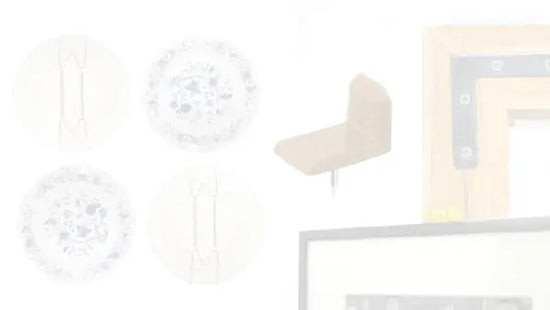Wall anchors are a MUST when it's not possible to hit a stud while hanging items on walls. Nails and screws can easily slip out or cause the wall to break apart if an anchor isn't used, and picking the right type and installing them correctly are crucial.
In this beginner's guide, we will take you through the basics of how to use wall anchors and how to choose the right one.
Tools Needed
Make sure you gather all the necessary tools for your project:

Step 1: Determine the type of wall you're working with
The type of wall you're working with will determine the type of wall anchor you need. There are three main types of wall substrates: plaster wall, drywall and masonry.
Plaster wall is made by nailing strips of wood (also known as laths) over wall studs. Then, the laths are covered with layers of plaster to create a smooth surface.
Drywall is also known as plasterboard and consists of two paperboards that sandwich gypsum, a powdery white or gray sulfate mineral.
Lastly, masonry walls are made of concrete, brick, or stone. Masonry is a term in the construction field wherein mortar is used to bind individual units of bricks, stones, marbles, concrete, etc.

If you're not sure what type of wall you have, knock on the wall. If it sounds hollow, it's likely a drywall wall. If it sounds solid, it's likely a plaster or masonry wall.
Related Article: 5 Ways to Know If You Have a Plaster Wall or Drywall
Step 2: Choose the right anchor
Once you know what type of wall you're working with, you can proceed to choosing the wall anchor most suitable for it.
Wall anchors come in a variety of sizes and types, including plastic, metal, and toggle anchors. Plastic drywall anchors are suitable for hanging lightweight items such as pictures on drywall, while metal and toggle anchors are better for heavier items such as shelves.
What wall anchors are available in Picture Hang Solutions?
Choosing which wall anchor to use will not only depend on wall type, but weight capacity as well. There’s a limit to how heavy a weight a wall anchor can support. As mentioned above, plastic anchors are best for lightweight items while zinc or metal anchors are ideal for heavier items.

Most wall anchors have specified weight ratings such as the Snap Skru Anchor, Zinc Drywall Anchor, and the Snap Toggle Anchor. See above for their specific weight capacity.
However, even though the other wall anchors do not have a specified weight limit, it is still indicated what types of applications they’re best suited for. The white and blue plastic wall anchors are to support lightweight items while the lead anchor is best for medium-duty applications.
Step 3: Drill a hole in the wall
After choosing the wall anchor, you can now start the installation process.
Use a drill to make a pilot hole on the wall. Make sure to use a drill bit that’s slightly smaller than the diameter of the anchor. If you’re working with drywall, be careful not to drill too deeply, as this might lead to wall damage.
⚒️ PRO TIP: Use masking tape to mark the depth or the length of size of the screw you will install.

Step 4: Insert the anchor
Once you've drilled the hole, insert the anchor into the hole. Tap the anchor lightly with a hammer until it is flush with the wall.
If you're using a snap toggle anchor, make sure the wings are folded down before inserting it into the hole. Slide the small plate up to lock the toggle anchor in position. Then, press down on the plate against the wall while pulling back the legs to secure. To break the legs, bend it down to separate the finger grips first. Then, spread it apart until it snaps off.
Check out this video for visual reference:
Step 5: Screw in the item you’re hanging
Now that the anchor is in place, you can screw in the item you want to hang. Make sure to use the right size screw for the anchor, and be careful not to overtighten the screw, as this can damage the anchor.

Step 6: Test the strength of the anchor
Once the item is hung, give it a gentle tug to test the strength of the anchor. If the anchor feels loose, you may need to remove it and try a larger size.
How to Remove Wall Anchors
If you decide you want to remove the anchor, follow the steps below depending on the type of anchor/wall you have:
For standard wall anchors on drywall or plaster wall:
1. Insert the screw halfway back to the anchor on the wall.
2. For drywall, use pliers to hold the screw and pull it out. The anchor will be pulled out with it.
3. For plaster walls, you will need a small piece of wood with a hole slightly bigger than the head of the screw. Slip it through the screw and anchor and hold it down while you pull them out.
For the Snap Toggle Anchor:
1. Get a screwdriver with a slotted head.
2. On the left side of the Snaptoggle Anchor on the wall, position the head just under anchor as if you’re going to scrap it. Then, hammer down gently.
3. Repeat Step 2 on the other sides.
4. Insert the screw on the hole and hammer it down as shown in the video.
5. Pull out the anchor with the assistance of the screwdriver.

Final Thoughts
While wall anchors may appear less intimidating than other products, their application can be tricky, and their value is often overlooked. It's important to note that without hitting a stud, nails or screws alone aren't sufficient – most wall types require the reinforcement that a wall anchor provides to prevent slipping. By utilizing wall anchors, you can ensure that your pictures, art, or decor items remain securely in place, preventing damage to your walls and the objects themselves.
If you have more questions, feel free to email us at support@picturehangsolutions.com. Our team will be happy to assist you!








Leave a comment (all fields required)